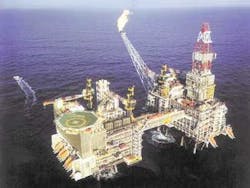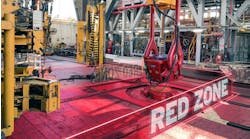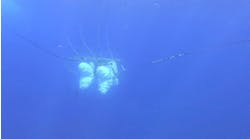DOWNHOLE COMMUNICATIONS: North Sea platform proves permanent monitoring reliability
Withstanding the test of time
John Mason
Amerada Hess
Jim Laidlaw
Sudhir Pai
Schlumberger
Having withstood the test of time, an early permanent monitoring installation on the Scott platform in the North Sea now offers proof that permanent monitoring in offshore installations is not only cost effective, but has proven reliability – surviving and performing "longer than anyone expected," according to project managers at Amerada Hess.
The Scott and Telford reservoirs in the North Sea have been continuously monitored in the subsurface environment for more than eight years using a permanent monitoring and control installation. The installation includes downhole gauges with state-of-the-art components designed to function reliably without maintenance or retrieval.
Amerada Hess Scott platform.
null
Permanent monitoring systems measure and record well performance and reservoir behavior from sensors mounted on the tubing string and placed downhole during well completion operations. These measurements are communicated up the well bore using advanced telemetry systems and then made available to appropriate engineers worldwide via satellite and secure networks. The systems deliver the information essential to dynamically manage hydrocarbon assets, allowing engineers to optimize production, diagnose problems, refine field development, and take remedial action, all based upon accurate information about the reservoir, received from the reservoir.
Both reservoir and well or production behavior can be monitored in real time, 24 hours a day, day after day, throughout the life of the reservoir.
Put to the test
While the Scott platform sits in 466 ft of cold water, 117 mi northeast of Aberdeen, and bravely bears the icy winds and waters of the UK sector of the North Sea, the earth's natural geothermal gradient raises the water temperature 2 mi below the seabed to more than boiling. This development was the largest oil and gas field to come onstream in the UK North Sea during the 1990s. Permanent quartz gauges have been monitoring the production of both the Scott and Telford reservoirs for over eight years at temperatures and pressures ranges of 266°F and 8,000 psi and at a well depth of over 12,000 ft.
The WellWatcher system, comprising the subsurface gauges, cables, connectors, and surface data delivery system developed by Schlumberger, has provided valuable information for Amerada Hess. The product development is based on rigorous engineering and development processes to ensure that its products will meet the expectations that have been set. The continued performance of the gauge systems is testament to the value of this process. The data provided by these gauges continues to help improve reservoir understanding and have added value to the project.
Prior to Schlumberger's participation in this market, downhole pressure gauges had limited high-temperature lifetimes because they were basically modified pressure logging tools. Such temporary technology is not suited to high-temperature, offshore environments, where equipment retrieval is prohibitively expensive. Since these are offshore wells, maintenance is generally out of the question.
The permanent installation on the Scott platform holds a field track record of demonstrated offshore reliability of over 85% at five years. The figure is continuously improved by means of an ongoing process of failure reporting and corrective action. Analysis of field track records from hundreds of installations helps to pinpoint failures and to focus engineering resources on opportunities for improvement.
Early experience on Scott, with fully redundant dual systems, highlighted problems with the wellhead connections and feed-throughs. These problems resulted in damaged cables.
A novel cable clamp for use in the tubing hanger was developed to alleviate these problems. The improvement in installation success allowed Amerada Hess to select a conventional system, thus realizing considerable equipment cost savings. This success underlines the need to address system reliability rather than focusing on the reliability of individual components.
Defining permanent
Although permanent monitoring systems have been around since the early 1960s, the technology evolved slowly. In the early 1990s, a detailed research and development project was launched to create a permanent monitoring system that would be based on "long-lived technology" from the ground up.
In a circa 1960 monitoring system, the pressure gauge was hung on the bottom of the tubing and communicated with the surface via a cable strapped to the outside. Connection to the gauge downhole and recording equipment at surface was through insulated ports. This setup caused restrictions in flow and also prevented access to the well below the gauge.
These early systems were essentially adaptations of electric wireline technology. Although such equipment was suited to production logging and well testing operations, the equipment's total accumulated downhole lifetime might amount to only a few weeks or months. Failures were caused by damage during installation or by cable problems at a later date – either by loss of electrical continuity or breakdown of insulation causing a short circuit.
A PressureWatch quartz gauge has been digitally monitoring well pressure and temperature for eight years in the North Sea.
.
Permanent technology allows a different approach. In a project with 40% funding by the European Community Thermie project, designers at the Riboud Product Center in Clamart, France, decided to weld the gauges shut and remove internal connectors. The result of these and other design innovations actually simplified the equipment and improved its reliability.
A key to success was the application of specialized high-temperature electronics along with a database of qualified components and suppliers. The resulting quartz family of downhole gauges, integrated as part of the WellWatcher systems, has established the current industry benchmark for reliability.
This system provides reliable downhole measurements at the well site, which can be easily integrated into SCADA, supervisory control and data acquisition system. Additionally, the system offers the ability to connect to secure data communications for transmission anywhere in the world.
A permanent gauge installation is an engineered system tailored to the well completion. The system is built of standard components carefully chosen to fit oil company requirements. The complete system ranges from pressure gauge to cable, from wellhead to data transmission.
Present systems are engineered in Clamart, France, and Rosharon, Texas, specifically for the permanent monitoring market and have a life expectancy that varies according to the conditions under which the system will be expected to operate. Gauges have digital electronics designed for extended exposure to high temperature and undergo extensive design qualification life tests and strict quality checks during manufacture before being hermetically sealed.
The reliability field track record has undergone continuous improvement by means of an ongoing process of failure-reporting and corrective action.
null
The quartz gauges utilize hermetically sealed quartz crystal resonators, digital electronics, and proprietary mechanical seals. Their associated surface units, which have a memory facility, are designed for rugged, long-duration operations.
Cables for permanent installations are encased in a stainless steel or nickel alloy capillary tube that is encapsulated in polymer. The combination of protective tube and polymer offer maximum resistance to crush and abrasion.
Connections to tubing hanger and wellhead vary depending on the type of completion (subsea, platform, or land), but components are standard. Cable protectors, tophole and wellhead connectors, data transmission and recording units, acquisition and software systems, and power supply are engineered for permanent installations.
Defining reliability
Reliability, a critical feature of all downhole equipment and surface systems, is inversely proportional to temperature, time, and wellbore chemistry. With continuing field reviews from all installations, including those in the ultimate offshore subsea environment, performance analysis leads to continual improvements in system design to push the performance envelope even further. Accelerated life testing of components at high temperature and pressure is ongoing.
Sound project management and permanent technology that is designed to meet the demanding surface and sub-surface conditions of the North Sea and still perform reliably is providing valuable insight into well and reservoir performance, almost as an insurance against unexpected subsurface events.






